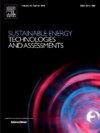负荷扰动下梯级水电站运行稳定性研究
IF 7
2区 工程技术
Q1 ENERGY & FUELS
Sustainable Energy Technologies and Assessments
Pub Date : 2025-06-13
DOI:10.1016/j.seta.2025.104401
引用次数: 0
摘要
梯级水电站的联合运行是一个复杂的挑战,涉及多个水电设施的水力互联。目前,这种级联系统的运行稳定性仍然不确定。本文研究了由小容量调节水库(THS-CRR)连接的两座水电站的运行稳定性。首先,建立了该系统的数学模型。随后,对不同水力连接方式下水电站的稳定性进行了分析。此外,还分析了液压连杆对运行稳定性的影响。最后,给出了选择调控器参数的建议。研究结果表明,梯级水电站之间的水力连接可能会损害稳定性,因为调节水库的水位波动会影响下游电站的输出功率。具体而言,当水位变化抵消了流量变化时,系统难以维持流量平衡,无法满足负荷需求,导致系统不稳定。为提高稳定性,建议上游电站采用较小的调速器参数,下游电站采用较大的调速器参数。本文章由计算机程序翻译,如有差异,请以英文原文为准。
Operational stability of cascade hydropower stations under load disturbances
The joint operation of cascade hydropower stations presents a complex challenge, involving multiple hydropower facilities interconnected hydraulically. Currently, the operational stability of such cascading systems remains uncertain. This study examines the operational stability of two hydropower stations linked by a small-volume regulating reservoir (THS-CRR). Initially, a mathematical model for THS-CRR is developed. Subsequently, the stability of hydropower stations with varying hydraulic connections is analyzed. Additionally, the impact of hydraulic links on operational stability is elucidated. Finally, recommendations for selecting governor parameters are provided. The findings suggest that hydraulic links between cascade hydropower stations may compromise stability, as fluctuations in the water level of the regulating reservoir influence the power output of the downstream station. Specifically, when water level variations counteract discharge changes, the system struggles to maintain discharge balance and meet load demands, resulting in instability. To enhance stability, using smaller governor parameters for the upstream station and larger ones for the downstream station is advisable.
求助全文
通过发布文献求助,成功后即可免费获取论文全文。
去求助
来源期刊

Sustainable Energy Technologies and Assessments
Energy-Renewable Energy, Sustainability and the Environment
CiteScore
12.70
自引率
12.50%
发文量
1091
期刊介绍:
Encouraging a transition to a sustainable energy future is imperative for our world. Technologies that enable this shift in various sectors like transportation, heating, and power systems are of utmost importance. Sustainable Energy Technologies and Assessments welcomes papers focusing on a range of aspects and levels of technological advancements in energy generation and utilization. The aim is to reduce the negative environmental impact associated with energy production and consumption, spanning from laboratory experiments to real-world applications in the commercial sector.
 求助内容:
求助内容: 应助结果提醒方式:
应助结果提醒方式:


